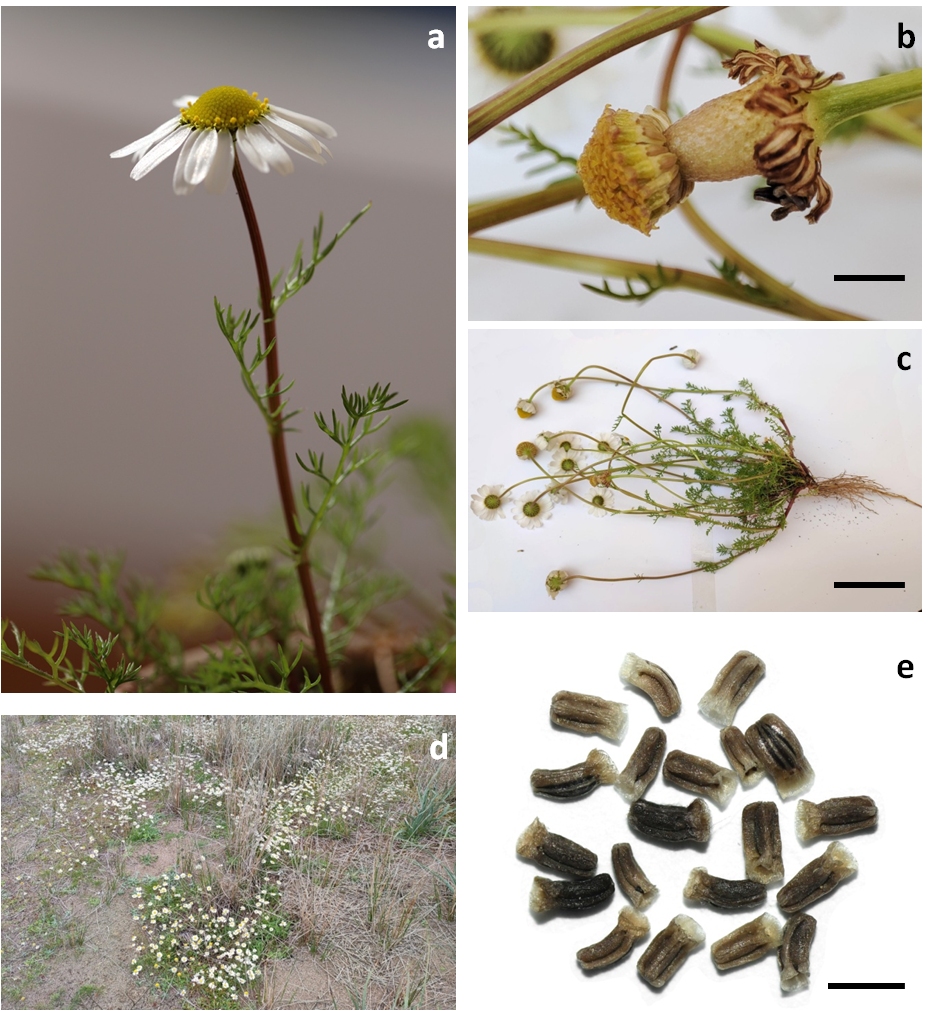Tripleurospermum parviflorum (Asteraceae): a new record for the flora of Greece
DOI:
https://doi.org/10.3986/hacq-2025-0016Keywords:
Anthemideae, East Aegean Islands, Lesvos, new record, phytogeographyAbstract
Tripleurospermum parviflorum, recently collected on the island of Lesvos, Greece, turned out to be a new floristic record for the country. A description based on the new material is provided, together with a distribution map of all the Tripleurospermum species occurring on the island. The diagnostic features that distinguish T. parviflorum from the remaining Greek species are highlighted and the chromosome number, as well as the karyotype formula of one, out of two newly discovered populations is presented. A dichotomous key for all the Greek Tripleurospermum species facilitates proper identification. The new discovery stresses the important presence of Anatolian elements in the flora of the East Aegean Islands in general and on Lesvos, in particular.
Downloads
References
Altınordu, F., Peruzzi, L., Yu, Y., & He, X. (2016). A tool for the analysis of chromosomes: KaryoType. Taxon 65(3), 586–592. https://www.jstor.org/stable/taxon.65.3.586
Avetisian, V. E., & Oganesian, M. E. (1995). Flora Armenii 9. Campanulaceae, Asteraceae. Koeltz Scientific Books.
Bazos, I. (2005). Study of the flora and vegetation of Lesvos (East Aegean Islands, Greece) (Publication No. 23178) [Doctoral dissertation, National and Kapodistrian University of Athens]. National Archive of PhD Theses. http://dx.doi.org/10.12681/eadd/23178
Bazos, I., & Yannitsaros, A. (2004). Floristic reports from the island of Lesvos (Greece) I. Dicotylédones: Aceraceae to Guttiferae. Edinburgh Journal of Botany, 61(1), 49–86. https://doi.org/10.1017/S096042860400006X
Davis, P. H. (1965). Flora of Turkey and the East Aegean Islands, Vol. 1. Edinburgh University Press.
Dimitrov, D. S. (2021). Tripleurospermum disciforme (C. A. Mey) Sch. Bip. In E. von Raab-Straube & Th. Raus (Eds.), Euro+Med-Checklist Notulae, 14 (pp. 357). Willdenowia, 51(3), 355–369. https://doi.org/10.3372/wi.51.51304
Dimopoulos, P., Raus, Th., & Strid, A. (2024). Flora of Greece web, Version VI. Retrieved October 12, 2024, from https://portal.cybertaxonomy.org/flora-greece/intro
Drinia, H., Dermitzakis, M. D., Kouli, K., & Tsourou, Th. (2002). Sedimentary facies analysis and paleoenvironmental interpretation of Vatera formation, Lesvos island, Greece. Annales Géologiques des Pays Helléniques, 39, 15–35.
Enayet Hossain, A. B. M. (1975). Tripleurospermum Schultz Bip. In P. H. Davis (Ed.) Flora of Turkey and the East Aegean Islands, Vol 5 (pp. 295–311). Edinburgh University Press.
GBIF [Global Biodiversity Information Facility]. (n.d.). Tripleurospermum parviflorum (Willd.) Pobed. Retrieved October 14, 2024, from https://www.gbif.org/species/3104214
Goula, K., & Constantinidis, Th. (2023). Anthemis sect. Hiorthia (Asteraceae) on Kriti Island, Greece: high ploidy levels and a new species. PhytoKeys, 229, 113–129. https://doi.org/10.3897/phytokeys.229.102703
Greuter, W. (2006+). Compositae (pro parte majore). In W. Greuter, & E. von Raab-Straube (Eds.) Compositae. Euro+Med Plantbase - the information resource for Euro-Mediterranean plant diversity. Retrieved October 13, 2024, from https://europlusmed.org/cdm_dataportal/taxon/850e2492-ff0d-44f6-ad32-110f4aba70d5
Inceer, H., & Beyazoglu, O. (2004). Karyological studies in Tripleurospermum (Asteraceae, Anthemideae) from north-east Anatolia. Botanical Journal of the Linnean Society, 146(4), 427–438. https://doi.org/10.1111/j.1095-8339.2004.00334.x
Inceer, H., & Hayırlıoǧlu-Ayaz, S. (2010). Chromosome numbers in Tripleurospermum Sch.Bip. (Asteraceae) and closely related genera: relationships between ploidy level and stomatal length. Plant Systematics and Evolution, 285(3-4), 149–157. https://doi.org/10.1007/s00606-009-0266-5
Inceer, H., Garnatje, T., Hayırlıoğlu-Ayaz, S., Pascual-Díaz, J. P., Vallès, J., & Garcia, S. (2018). A genome size and phylogenetic survey of Mediterranean Tripleurospermum and Matricaria (Anthemideae, Asteraceae). PLoS ONE, 13(10), e0203762. https://doi.org/10.1371/journal.pone.0203762
Kay, Q. O. N. (1976). Matricaria L. (Tripleurospermum Schultz Bip.). In T. G. Tutin, V. H. Heywood, N. A. Burges, D. M. Moore, D. H. Valentine, S. M. Walters & D. A. Webb (Eds.) Flora Europaea, Vol. 4 (pp. 165–167). Cambridge University Press.
Levan, A., Fredga, K., & Sandberg, A. A. (1964). Nomenclature for centromeric position on chromosomes. Hereditas, 52(2), 201–220. https://doi.org/10.1111/j.1601-5223.1964.tb01953.x
Oberprieler, C. (2001). Phylogenetic relationships in Anthemis L. (Compositae, Anthemideae) based on nrDNA ITS sequence variation. Taxon, 50(3), 745–762. https://doi.org/10.2307/1223705
Oberprieler, C., Töpfer, A., Dorfner, M., Stock, M., & Vogt, R. (2022). An updated subtribal classification of Compositae tribe Anthemideae based on extended phylogenetic reconstructions. Willdenowia, 52(1), 117–149. https://doi.org/10.3372/wi.52.52108
Pobedimova, E. G. (1961). Genus 1527. Tripleurospermum Sch-Bip. In B. K. Schischkin, & E. G. Bobrov (Eds.) Flora of the USSR, Volume XXVI Compositae, Tribes Anthemideae, Senecioneae, and Calenduleae (pp. 152–177). Amerind Publishing Co. Pvt. Ltd. [translated in English 2000]. Available at https://www.biodiversitylibrary.org/item/94981#page/8/mode/1up
POWO [Plants of the World Online]. (n.d.). Tripleurospermum parviflorum (Willd.) Pobed. Retrieved October 14, 2024, from https://powo.science.kew.org/taxon/urn:lsid:ipni.org:names:256514-1
Rechinger, K. H. fil. (1943). Flora Aegaea. Flora der Inseln und Halbinseln des ägäischen Meeres. Denkschriften der Kaiserlichen Akademie der Wissenschaften / Mathematisch-Naturwissenschaftliche Classe 105(1).
Schischkin, B. K., & Bobrov, E. G. (1961). Flora of the USSR, Volume XXVI Compositae, Tribes Anthemideae, Senecioneae, and Calenduleae. Amerind Publishing Co. Pvt. Ltd. [translated in English 2000]. Available at https://www.biodiversitylibrary.org/item/94981#page/8/mode/1up
Strid, A. (2016a). Atlas of the Aegean flora, Part 1: Texts and Plates. Englera 33, 1–700.
Strid, A. (2016b). Atlas of the Aegean flora, Part 2: Maps. Englera 33, 1–878.
Strid, A. (2024). Atlas of the Hellenic Flora, I. Broken Hill Publishers Ltd.
Strid, A., & Tan, K. (1997). Flora Hellenica, 1. Koeltz.
Thiers, B. (2024 [continuously updated]). Index Herbariorum: A global directory of public herbaria and associated staff. Retrieved October 10, 2024, from http://sweetgum.nybg.org/ih/

Downloads
Published
How to Cite
Issue
Section
License
Copyright (c) 2025 ZRC-SAZU

This work is licensed under a Creative Commons Attribution-NonCommercial-NoDerivatives 4.0 International License.
Authors guarantee that the work is their own original creation and does not infringe any statutory or common-law copyright or any proprietary right of any third party. In case of claims by third parties, authors commit their self to defend the interests of the publisher, and shall cover any potential costs.
More in: Submission chapter












